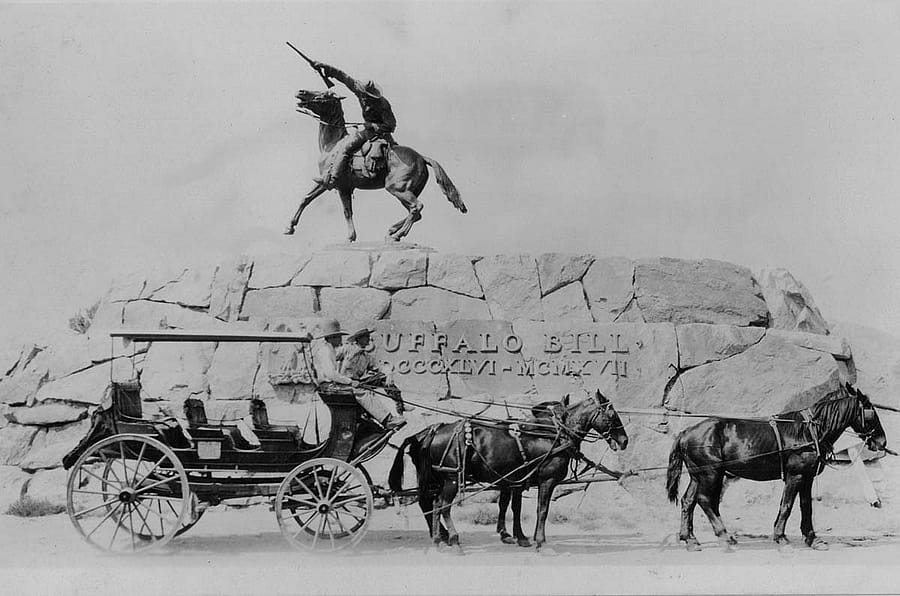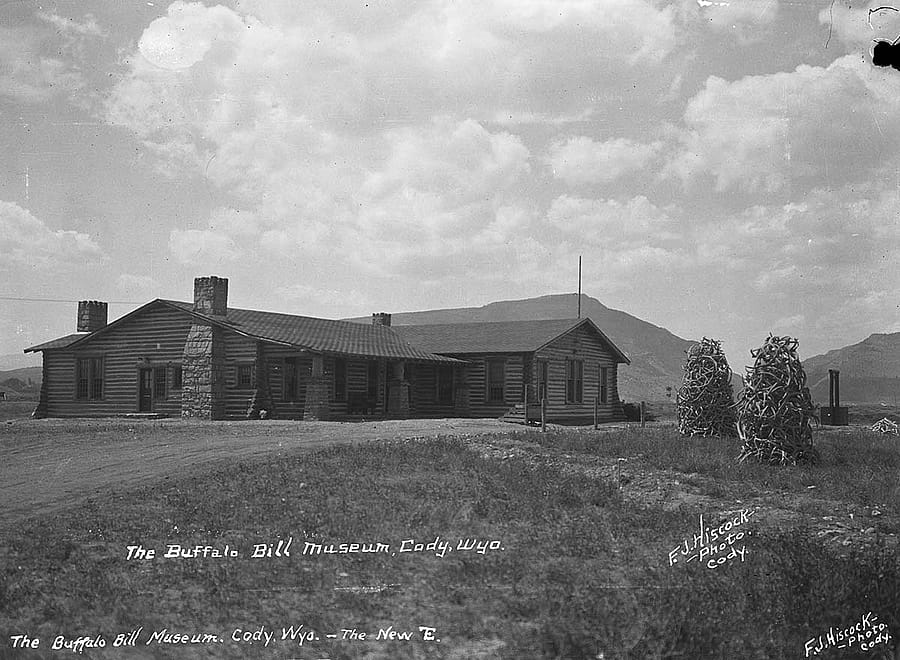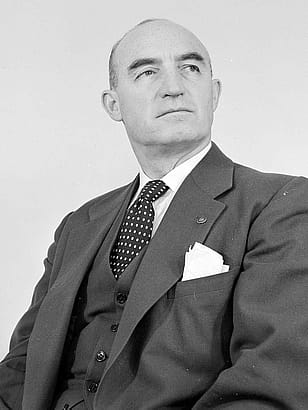
Reflecting on the Center’s Past, Imagining its Future – Points West Online
Originally published in Points West magazine
Spring 2018
Pete and Al: Reflecting on the Center’s Past, Imagining its Future
By Michaela Jones
For one hundred years, the Buffalo Bill Center of the West has shared the story of the authentic American West with millions of visitors. For many travelers, the wild scenes of the frontier, artwork ranging from cowboy to contemporary, the comprehensive collection of firearms, and the ecosystem of the nearby cherished Yellowstone National Park create a long-lasting impression. These vibrant visions of a time long ago unite under one roof to create the most remarkable tribute to the West, and it simply isn’t something that’s easily forgotten. In fact, many travelers fondly remember the Center years after their visit.
But for some, the attachment to the Center of the West runs much deeper. In a recent interview, brothers Peter K. Simpson (United States Navy veteran, Screen Actors Guild card holder, historian, former professor, and actor) and Alan K. Simpson (former United States Senator, R-Wyo., United States Army veteran, historian, and author) share their insights to the Center of the West’s past, present, and future, and explain how the Simpson family roots are forever intertwined with its rich history.

Do you think the original members of the Buffalo Bill Memorial Association imagined what the Center of the West would grow to become?
“They imagined greatness,” Al said of the members of the Buffalo Bill Memorial Association (BBMA).
Following William F. “Buffalo Bill” Cody’s death on January 10, 1917, the townspeople desired to create a meaningful tribute to commemorate his life, legacy, and history. This desire resulted in a meeting on the front porch of the local Irma Hotel to discuss and consider the many ways they could choose to honor their town’s beloved namesake.
Only seven weeks after Cody’s death, the group that began as a simple, informal association of individuals soon flourished into a formal establishment of the BBMA.
The original members of the BBMA (Margaret L. Simpson, grandmother of Al and Pete Simpson; L.L. Newton; Charles Hayden; W.T. Hogg; and Sam Parks) initially considered creating a park in Cody’s memory, though their idea soon expanded and turned into something far more grand.
Following much deliberation and planning, prominent American sculptor and talented New York artist Gertrude Vanderbilt Whitney sculpted the monumental bronze statue Buffalo Bill—The Scout.

After completing the memorial, Whitney purchased forty acres of land in view of the Shoshone Canyon and the beautiful surrounding mountains—a spot where the statue remains. The unveiling of the statue took place July 4, 1924, with an estimated 6,000–10,000 people in attendance. This memorial, which remains at the Center more than ninety years later, has emerged as an iconic image of the West, the town of Cody, and Buffalo Bill’s lasting legacy.
While the BBMA’s devotion to commemorate Cody’s life was unshakable, the Simpsons agreed that the original members would have been amazed to see such a comprehensive tribute to the West in a single, vast building.
“They imagined the perpetuity of the memory of Buffalo Bill—they imagined that as forever,” Pete stated.
In present day, would this institution meet the expectations of your grandmother, Margaret Simpson?
In a 2016 interview for Points West, Pete noted, “My grandmother knew Buffalo Bill, and he was simply enamored of her. He brought her a rose every time he came into town.” Margaret—or “Maggie” as many called her—and Buffalo Bill had a friendship that spanned many years.
Though there are many Simpson family stories woven throughout the history of the town of Cody, one in particular always stands out for Al and Pete. Following the opening of the Irma Hotel, an extravagant ball was scheduled, and it was certain Buffalo Bill would be present. The town of Cody buzzed with excitement, and everyone knew it was an event not to be missed.
Unfortunately, Al explained, Margaret sprained her ankle leading up to the ball and knew she would be unable to attend. Shortly after her injury, disappointed and distressed, she was sitting alone by the ditch when—to her surprise—Buffalo Bill arrived to visit her.
“She was sitting there with her leg up,” Al explained, “and then Buffalo Bill said, ‘Maggie, I’m so sorry that you can’t make the ball.’ Then he sang the song, ‘When you and I were young, Maggie,’ which is a great old song, and then he did the customary cowboy hat tilt,” Al added.
“He even brought her flowers—she talked about that for years.”
“She was thoroughly enamored,” Pete laughed. “Given the fact that she already saw [the Center’s] direction and its development with at least two of these wings, I think she’d be immensely satisfied.”
Throughout the past one hundred years, this institution that started as a small log cabin has flourished into five museums and a research library. How do you envision the Center of the West in its bicentennial?
“As the next hundred years progresses in this country, who knows where we’re going to be?” Pete said. “Wherever we’re going to be, there are always lessons to be taught.”
For example, Pete explained, the Papers of William F. Cody have shown that Buffalo Bill’s complex, ever-unfolding role offers a wide range of topics to be further explored for many years to come. The Papers have also demonstrated that teaching takes place with every generation.
“History, if anything, is simply refocusing the lens of the present of where you are now on the past—circumstances in the present lead you to ask different questions of the past,” Pete noted. “As a consequence, different questions will be asked fifty years from now, seventy-five years from now, or a hundred years from now.”
“As long as there is a Yellowstone Park, there will be a Buffalo Bill Center of the West,” Pete added. “People, I think, are going to come here to see a place that is largely pristine—that is saved in nature with the Park, and with our America’s First National Forest and other things. [Cody] will be a place of destination to revive and refresh one’s memory.”
What are your most memorable moments at this museum?
“I can think of so many,” Al chuckled.
The Simpson brothers agreed that perhaps the funniest memory—though not exactly funny at the time—was the arrival of Cornelius Ryan, author of The Longest Day. He was on hand to dedicate the Buffalo Bill Museum in its new location on July 4, 1968. (The Museum would open to the public in 1969.)
“He [Ryan] was big at the time,” Pete noted.
“He came to dedicate the museum, and Dad (Milward L. Simpson) was the emcee and introduced him,” Al added.
As a whole, the dedication was intended to be quite a memorable event for all who attended. After making a slew of intricate arrangements, the plan was simple: First, a giant, fiberglass buffalo was to be tethered to a helicopter. Then, just as Ryan was nearing the end of his speech, the helicopter would leave the airport, land with the buffalo at the dedication for all to see, and then fly it to the top of Cedar Mountain where it was to be placed on a pedestal. There Buffalo Bill had always said he wanted a massive bison statue, and once in place, the spirit of Buffalo Bill would be renewed.
Despite careful planning prior to the event, though, the arrangements did not exactly come to fruition as all had hoped. “Well, Ryan is mesmerizing people with his speech,” Al explained. “And all of a sudden in the distance to the east, we heard a chopper, and people looked way back over the eastern hills. Ryan is in the middle of his speech, and turns to my father and says, ‘What is that?!’”
Unfortunately, it did not take long for the massive crowd to realize the pilot was a little off in calculating the correct time of arrival. Because of all the racket, Ryan initially decided he would not finish his speech despite attempts to calm him down.
“Like any great speaker, he had prepared a beautiful talk,” Al noted. However, the early arrival of the helicopter really “threw a wrench” into the original plans. Fortunately, organizers soon decided that the giant fiberglass buffalo must be taken back.

Pete also explained that he, too, had a favorite memory related to the dedication of what is now the Cody Firearms Museum. “It wasn’t right here at the museum, but I’ll never forget the dedication of the Winchester Museum with Curt Gowdy and John Wayne,” Pete recalled.
It was 1976, and Pete was living in Casper at the time having just participated in a production of 1776, a musical based on the events surrounding the signing of the Declaration of Independence. He played the part of Richard Henry Lee, and on the first night of the show, there was a bit of an accident as he made an “energetic” exit off stage as part of a scene during the play.
“Well, Ben Franklin and Tom Jefferson ran into me and broke a metatarsal in my foot, which meant I had a cast on my leg at the time [of the dedication],” Pete explained.
Following the dedication of the Winchester Museum, Chairman of the Board of Trustees, Peg Coe, held a reception at her home where John Wayne was scheduled to be a guest. “I was thrilled to be there, but I was hobbling with my cast, and I had the occasion to be introduced to John Wayne,” Pete recalled. “He was smiling and had a little drink in his hand.”
Once he approached the iconic western celebrity, Pete told him how honored and thrilled he was to meet him. Wayne carefully eyed his cast with a smile, leapt forward—as if he was going to stomp on Pete’s foot—and then quickly pulled back. Startled, Pete promptly jumped back, and Wayne began to laugh hysterically. “[Wayne] asked if it still hurt, and I said, ‘It would have!’”

Despite the brief—but comical—scare, Pete said it was a truly fun moment with a notable individual.
“There were so many amazing people who would come, and they would make themselves available,” Al recalled. “All those stories are somewhere in the archive.”
Whether it was being involved in teaching or politics, or a variety of other duties, and you weren’t living in Cody, how did you each maintain your relationship with the Center?
Al observed that their mother (Lorna K. Simpson) was a very beautiful and talented woman. She knew Mary Jester Allen, niece of Buffalo Bill, who desired not only to commemorate her famous uncle’s life and legacy, but also to show travelers who arrived in Cody that the town had culture and excitement to offer. Allen would host high teas at the old log cabin building, and Lorna would play the piano for visitors, while someone else typically sang.

“There was no babysitter,” Al said. “Pete and I would be over there just messing around—and nobody paying a bit of attention. We’d get in the stagecoaches; there wasn’t anyone around.


Additionally, as children, every year, Pete and Al would faithfully go to the famed statue Buffalo Bill—The Scout on the Great Showman’s birthday and stand in the cold with the FFA (Future Farmers of America). “Mom loved and met Gertrude Vanderbilt Whitney, and loved the statue and admired her as an artist,” Pete recalled.
“It’s one hundred years of the bloodline,” Al noted. “Every time you drive down the main drag, you think, ‘look at that—look at that statue.’”
“All of what Al is talking about—you don’t forget it,” Pete said. “You have an attachment that comes from your roots, your beginnings…. Even when I was off in Oregon doing graduate work, or in the Navy, I read the Cody Enterprise [newspaper]. In the Navy I had to get it a month late.”
Following his service in the military, Pete explained that he had visited several European museums. “It kind of knocked me out that [the Center of the West] was in this town. It was solid, attractive, and beautifully designed, and I remember being very struck by that after being out of town.
“It’s always been a living part of our memories, and I was both honored and thrilled to be a part of one of the advisory boards here,” Pete shared. “It’s a matter of serving an institution that you have not only come to know, but love, too.”
Although no one may know exactly what the Center of the West’s next one hundred years hold, as Al says, there is something we can be certain of: “It will be here, and it will match the grandeur we see now in a different way.”
About the author
Michaela Jones, a Cody, Wyoming, native, was the Centennial Media intern at the Center of the West for the summer of 2017. She graduated from the University of Wyoming with a bachelor’s in English and minors in professional writing and psychology. She served as Communications Specialist at Northwest College in Powell, Wyoming, and is now Alumni & Development Coordinator there.
Post 341
Written By
Nancy McClure
Nancy now does Grants & Foundations Relations for the Center of the West's Development Department, but was formerly the Content Producer for the Center's Public Relations Department, where her work included writing and updating website content, publicizing events, copy editing, working with images, and producing the e-newsletter Western Wire. Her current job is seeking and applying for funding from government grants and private foundations. In her spare time, Nancy enjoys photography, reading, flower gardening, and playing the flute.
















